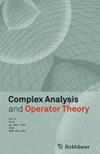Browder S-Resolvent Equation in Quaternionic Setting
IF 0.7
4区 数学
Q2 MATHEMATICS
引用次数: 0
Abstract
This paper is devoted to the study of the S-eigenvalue of finite type of a bounded right quaternionic linear operator acting in a right quaternionic Hilbert space. The study is based on the different properties of the Riesz projection associated with the connected part of the S-spectrum. Furthermore, we introduce the left and right Browder S-resolvent operators. Inspired by the S-resolvent equation, we give the Browder’s S-resolvent equation in quaternionic setting.
四元背景下的布劳德 S-溶剂方程
本文致力于研究作用于右四元希尔伯特空间的有界右四元线性算子的有限类型 S 特征值。研究的基础是与 S 谱连接部分相关的 Riesz 投影的不同性质。此外,我们还引入了左布劳德和右布劳德 S-残差算子。受 S-溶剂方程的启发,我们给出了四元环境下的布劳德 S-溶剂方程。
本文章由计算机程序翻译,如有差异,请以英文原文为准。
求助全文
约1分钟内获得全文
求助全文
来源期刊
CiteScore
1.20
自引率
12.50%
发文量
107
审稿时长
3 months
期刊介绍:
Complex Analysis and Operator Theory (CAOT) is devoted to the publication of current research developments in the closely related fields of complex analysis and operator theory as well as in applications to system theory, harmonic analysis, probability, statistics, learning theory, mathematical physics and other related fields. Articles using the theory of reproducing kernel spaces are in particular welcomed.

 求助内容:
求助内容: 应助结果提醒方式:
应助结果提醒方式:


